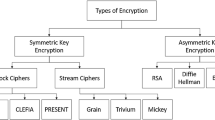Abstract
This paper presents an encryption scheme based on genetic operations and a new hybrid pseudo random number generator (HPRNG). The new HPRNG is designed based on linear feedback shift register (LFSR), chaotic asymmetric tent map and chaotic logistic map. The scheme uses XOR and genetic operations (mutation, and multipoint crossover) to encrypt the image blocks. The first block of the plain image is encrypted with the help of a pseudo-random bit sequence generated by the HPRNG. The subsequent blocks are based on the previous cipher block and the XOR operator. The scheme can be extended to encrypt color images and text as well. The cipher images produced have very low correlation with their corresponding plain images and have high values of entropy, making it unpredictable and difficult to detect redundancies in the image pixel values. More over the scheme is compared with some existing schemes and found that the proposed scheme is comparatively secure and efficient.
















Similar content being viewed by others
References
Bassham LE III, Rukhin AL, Soto J, Nechvatal JR, Smid ME, Barker EB, Leigh SD, Levenson M, Vangel M, Banks DL, Heckert NA, Dray JF, Vo S (2010) Sp 800-22 rev. 1a. a statistical test suite for random and pseudorandom number generators for cryptographic applications. Tech. rep., Gaithersburg, MD, United States
Belazi A, El-Latif AAA, Belghith S (2016) A novel image encryption scheme based on substitution-permutation network and chaos. Signal Process 128:155–170. https://doi.org/10.1016/j.sigpro.2016.03.021. http://www.sciencedirect.com/science/article/pii/S0165168416300147
Biswas K, Muthukkumarasamy V, Singh K (2015) An encryption scheme using chaotic map and genetic operations for wireless sensor networks. Sensors J IEEE 15(5):2801–2809. https://doi.org/10.1109/JSEN.2014.2380816
Boeing G (2016) Visual analysis of nonlinear dynamical systems: chaos, fractals, self-similarity and the limits of prediction. Systems, 4(4). https://doi.org/10.3390/systems4040037, http://www.mdpi.com/2079-8954/4/4/37
Fu C, bin Lin B, sheng Miao Y, Liu X, jie Chen J (2011) A novel chaos-based bit-level permutation scheme for digital image encryption. Opt Commun 284(23):5415–5423. https://doi.org/10.1016/j.optcom.2011.08.013. http://www.sciencedirect.com/science/article/pii/S0030401811008431
Jolfaei A, Wu X, Muthukkumarasamy V (2016) On the security of permutation-only image encryption schemes. IEEE Trans Inf Forens Secur 11(2):235–246. https://doi.org/10.1109/TIFS.2015.2489178
Li C, Zhang LY, Ou R, Wong KW, Shu S (2012) Breaking a novel colour image encryption algorithm based on chaos. Nonlin Dyn 70(4):2383–2388. https://doi.org/10.1007/s11071-012-0626-5
Li Y, Wang C, Chen H (2017) A hyper-chaos-based image encryption algorithm using pixel-level permutation and bit-level permutation. Opt Lasers Eng 90:238–246. https://doi.org/10.1016/j.optlaseng.2016.10.020. http://www.sciencedirect.com/science/article/pii/S0143816616303517
Mondal B, Mandal T (2017) A light weight secure image encryption scheme based on chaos & dna computing. J King Saud Univ- Comput Inf Sci 29 (4):499–504. https://doi.org/10.1016/j.jksuci.2016.02.003. http://www.sciencedirect.com/science/article/pii/S1319157816300027
Mondal B, Biswas N, Mandal T (2017) A comparative study on cryptographic image scrambling. In: Proceedings of the second international conference on research in intelligent and computing in engineering, annals of computer science and information systems, vol 10. PTI, pp 261–268, DOI https://doi.org/10.15439/2017R47
Mondal B, Kumar P, Singh S (2018) A chaotic permutation and diffusion based image encryption algorithm for secure communications. Multimedia Tools and Applications. https://doi.org/10.1007/s11042-018-6214-z https://doi.org/10.1007/s11042-018-6214-z
Nechvatal J, Barker E, Bassham L, Burr W, Dworkin M, Foti J, Roback E (2001) Report on the development of the advanced encryption standard (aes). J Res Nat Instit Standards Technol 106(3):511
Parvin Z, Seyedarabi H, Shamsi M (2014) A new secure and sensitive image encryption scheme based on new substitution with chaotic function. Multimed Tools Appl 75(17):10631–10648. https://doi.org/10.1007/s11042-014-2115-y
Tong X-J, Wang Z, Zhang M, Liu Y (2013) A new algorithm of the combination of image compression and encryption technology based on cross chaotic map. Nonlin Dyn 72(1-2):229–241. https://doi.org/10.1007/s11071-012-0707-5
Wang LT, McCluskey EJ (1988) Linear feedback shift register design using cyclic codes. IEEE Trans Comput 37(10):1302–1306. https://doi.org/10.1109/12.5994
Wang X, Wang Q (2014) A novel image encryption algorithm based on dynamic s-boxes constructed by chaos. Nonlin Dyn 75(3):567–576. https://doi.org/10.1007/s11071-013-1086-2
Zhou N, Zhang A, Zheng F, Gong L (2014) Novel image compression–encryption hybrid algorithm based on key-controlled measurement matrix in compressive sensing. Opt Laser Technol 62(2):152–160. https://doi.org/10.1007/s11433-009-0032-2
Author information
Authors and Affiliations
Corresponding author
Ethics declarations
This study was carried out at National Institute of Technology Jamshedpur. The research work/ study was not funded by any body or organization.
Conflict of interests
Author Dr. Bhaskar Mondal declares that he has no conflict of interest. Author Dr. Tarni Mandal declares that he/she has no conflict of interest.
Additional information
Ethical approval
This article does not contain any studies with human participants or animals performed by any of the authors.
Informed Consent
Informed consent was obtained from all individual participants included in the study.
Publisher’s note
Springer Nature remains neutral with regard to jurisdictional claims in published maps and institutional affiliations.
Rights and permissions
About this article
Cite this article
Mondal, B., Mandal, T. A secure image encryption scheme based on genetic operations and a new hybrid pseudo random number generator. Multimed Tools Appl 79, 17497–17520 (2020). https://doi.org/10.1007/s11042-019-08352-z
Received:
Revised:
Accepted:
Published:
Issue Date:
DOI: https://doi.org/10.1007/s11042-019-08352-z




